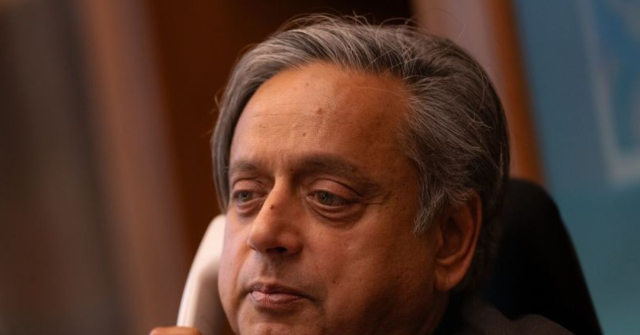India’s huge and growing population of workers and legal migrants in the United States should loudly defend India’s strategic interests, says a senior Indian politician.
“Silence is complicity,” wrote Shashi Tharoor, a UK-born politician who heads the Parliamentary Standing Committee on External Affairs in India’s parliament. He continued:
The silence of the diaspora is about the tension between success and solidarity, between assimilation and allegiance. For us in India, it is also about remembering that the voice of a community is not measured by its wealth or its titles, but by its willingness to stand up for the motherland when it matters most.
The demand that Indians in America — often called the “desi” population — champion Hindu or Indian solidarity is echoed by many Indian nationalists.
“There’s nothing really redeemable” among Trump and his “MAGA crowd,” said one Indian columnist who is hoping that FBI director Kash Patel will lobby Trump on behalf of India. “Will the dispoara step up?” for India, asked columnist Rhal Shivshanker.
But many Indians in American — and Indian-origin Americans — are opposed to India’s aggressive export of wage-cutting, subordinate workers into U.S. white-collar jobs, Tharoor admitted:
Indian-American friends tell me that many Indians who settled down in the U.S. a generation ago feel that [Indians on] H-1B visas are now hurting their own children’s opportunities. There is unemployment among recent [American] STEM graduates, even those with a computer science degree, and many of these are Indian-Americans. Tech companies prefer to replace more expensive American employees [including Indian-Americans] with cheaper H-1B visa holders. So, for such families, silence is tacit support for Trump’s policy.
The strategic problem for India’s government is that its economic strategy is built on the aggressive migration of Indians into white collar jobs throughout Europe, Australia, Japan, Ukraine, and the United States.
The U.S. government has helped more than 5 million Indian migrants move into the United States in the last 30 years, via various legal and illegal routes. For example, more than one million Indians have migrated via the H-1B and L-1 visa programs into an outsized share of jobs in the U.S. tech and medical sectors.
This economic strategy has been very successful for some U.S. investors and India. In 2024, Indian managers diverted many U.S. investments, contracts, and jobs back to India. They also sent roughly $38 billion in remittances back home. So Trump’s minor curb on India’s visas have sparked a middle-class uproar in India — and street burning of Trump effigies.
Trump’s economic pressure on India has prompted a major lobbying push by India’s diplomats. The campaign includes the formal hiring of lobbyists in the United States, sponsored posts on X, op-eds in established outlets, and contributions to various think tanks and universities.
But India’s migration strategy has alienated huge numbers of Americans by pushing them from prosperous careers and suburban homes. Pro-India Tharoor described the pushback:
The Donald Trump administration has mounted a series of policy assaults on India — slapping 50 percent tariffs on Indian goods, imposing a $100,000 fee on H-1B visa applications (of which Indians receive 70 percent), imposing sanctions on India’s strategic infrastructure work at the Iranian port of Chabahar, restricting student visas, and tightening immigration pathways, all accompanied by insults.
Many Indians have kept quiet amid the pushback because they are trying to integrate into U.S. life, Tharoor complained:
Indian-Americans, particularly those in positions of influence, often walk a tightrope between cultural pride and civic assimilation. Their success has been predicated on a careful calibration — celebrating Diwali without alienating Thanksgiving, invoking Gandhi without challenging Jefferson. To speak out forcefully in defense of India, especially when the critique is directed at the U.S. government, risks unsettling that balance. It invites scrutiny, suspicion, and the age-old question: Where do your loyalties lie?
“The response from this celebrated diaspora has been, at best, muted. At worst, it has been absent,” according to Tharoor:
The Indian-American community has the resources, the reach, and the respect to shape narratives. It can lobby Congress, influence the media, and mobilize public opinion. But it must first find its voice. Not a voice of blind nationalism, but of principled solidarity. Not a voice that echoes Delhi, but one that resonates in Washington.
But it is also true that many Indians in the United States are eager to boost Indian migrants.
“Indian-Americans are being unfairly targeted, both socially and through policy, while Democrats largely ignore or minimize their concerns,” claimed San Francisco lawyer Daniel Larson.
“If you want to hire someone from outside… that’s what… makes America the greatest country,” Philadelphia-based Indian immigrant Veene Aishwarya, told WHYY.org.
Indian migrants have gotten involved in American politics, most notably over the failed S.386 pro-Indian bill. In 2020, Breitbart News reported:
The primary lobby group for India’s contract workers in the United States is turning its invective against Sen. Rick Scott (R-FL) after he blocked the bipartisan bill to supercharge the flow of India’s visa workers into U.S. white-collar jobs.
The group, titled Immigration Voice, quickly posted a Facebook image of Scott in KKK garb after his August 5 surprise intervention in the effort by Sen. Mike Lee (R-UT) to pass his unpopular outsourcing bill.
Some Indians in India also oppose the demand that Indian migrants in American should express support for India’s government.
“You’re expecting the [Indians] in the U.S. to rise against Trump in his own territory, thereby exposing themselves to severe mortal harm,” said Sandeep Manudhane, who argues that the wealth extracted from the U.S. economy is held by a tiny number of super-rich Indians. “Diaspora won’t fight our battles,” he wrote.
Read the full article here
